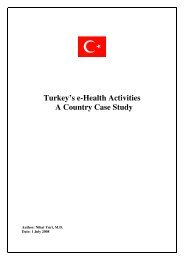e-Health Readiness Assessment Tools for Healthcare - Making the ...
e-Health Readiness Assessment Tools for Healthcare - Making the ...
e-Health Readiness Assessment Tools for Healthcare - Making the ...
Create successful ePaper yourself
Turn your PDF publications into a flip-book with our unique Google optimized e-Paper software.
428<br />
were one to four items in each section. The sections<br />
were <strong>the</strong>n grouped into four categories<br />
<strong>for</strong> each tool; core-readiness, societal readiness,<br />
and policy readiness were common to both <strong>the</strong><br />
tools. The fourth category in <strong>the</strong> tool <strong>for</strong> managers<br />
was called “technological readiness,”<br />
whereas <strong>the</strong> fourth category in <strong>the</strong> tool <strong>for</strong><br />
healthcare providers was called “learning<br />
readiness.”<br />
Draft tools were tested <strong>for</strong> validity and reliability.<br />
12,13 The final tools contained 54 items<br />
<strong>for</strong> managers and 50 items <strong>for</strong> healthcare<br />
providers. Each of <strong>the</strong> categories, along with all<br />
<strong>the</strong> items, is described below and illustrated in<br />
Tables 1–5.<br />
Category I—Core readiness<br />
This category was common in both <strong>the</strong> tools,<br />
and addressed <strong>the</strong> overall planning process <strong>for</strong><br />
a proposed e-health program, and <strong>the</strong> knowledge<br />
and experience of planners with programs<br />
using ICT. Specific core-readiness items<br />
dealt with <strong>the</strong> importance of needs assessment,<br />
key aspects of planning, and <strong>the</strong> determinants<br />
of accessibility such as appropriateness of technology,<br />
and integration of technology with existing<br />
services (Table 1).<br />
KHOJA ET AL.<br />
Category II—Technological readiness<br />
This category was included in <strong>the</strong> tool <strong>for</strong> managers<br />
only, and addressed <strong>the</strong> availability and af<strong>for</strong>dability<br />
of required ICT, and <strong>the</strong> hardware<br />
and software needed to implement a proposed<br />
program. Specific technological readiness items<br />
dealt with physical access to technology along<br />
with determinants of accessibility such as af<strong>for</strong>dability<br />
and capacity building (Table 2).<br />
Category III—Learning readiness<br />
This category was included in <strong>the</strong> tool <strong>for</strong><br />
healthcare providers only, and addressed issues<br />
related to <strong>the</strong> existence of programs and<br />
resources to provide training to healthcare<br />
providers in using <strong>the</strong> technology. Specific<br />
learning readiness items dealt with <strong>the</strong> inclusion<br />
of healthcare providers in <strong>the</strong> planning<br />
process and determinants of accessibility such<br />
as capacity building (Table 3).<br />
Category IV—Societal readiness (ICT use<br />
and interaction)<br />
This category was included in both <strong>the</strong> tools,<br />
and dealt with any existing interaction of <strong>the</strong><br />
concerned institution with o<strong>the</strong>r healthcare in-<br />
TABLE 2.<br />
COMPOSITION AND FORMAT OF CATEGORY OF TECHNOLOGICAL READINESS<br />
Statements: 1 2 3 4 5 D/K<br />
Speed and quality of ICT/Internet at <strong>the</strong> institution:<br />
1. Speed of connections is appropriate <strong>for</strong> <strong>the</strong> proposed use 1 2 3 4 5 D/K<br />
2. Quality of connections is appropriate <strong>for</strong> <strong>the</strong> proposed use 1 2 3 4 5 D/K<br />
Service/Support <strong>for</strong> ICT:<br />
1. Service/support is available within a reasonable time frame <strong>for</strong> <strong>the</strong> 1 2 3 4 5 D/K<br />
proposed use.<br />
2. Local support is proficient to address most of <strong>the</strong> problems related 1 2 3 4 5 D/K<br />
to <strong>the</strong> proposed use.<br />
Hardware and software:<br />
1. Hardware and software required <strong>for</strong> <strong>the</strong> proposed project are 1 2 3 4 5 D/K<br />
readily available.<br />
2. Hardware and software required <strong>for</strong> <strong>the</strong> proposed project are 1 2 3 4 5 D/K<br />
readily af<strong>for</strong>dable.<br />
Availability and af<strong>for</strong>dability of <strong>the</strong> desired ICT<br />
1. Required ICT (telephone/internet/bandwidth) is easily available 1 2 3 4 5 D/K<br />
<strong>for</strong> <strong>the</strong> institution.<br />
2. Required ICT (telephone/internet/bandwidth) is easily available 1 2 3 4 5 D/K<br />
<strong>for</strong> <strong>the</strong> institutions involved.<br />
Institutional access to ICT/Internet training:<br />
1. Programs are in place to train <strong>the</strong> users <strong>for</strong> proposed project. 1 2 3 4 5 D/K<br />
2. Manpower is in place to train <strong>the</strong> users <strong>for</strong> proposed project. 1 2 3 4 5 D/K<br />
Score



